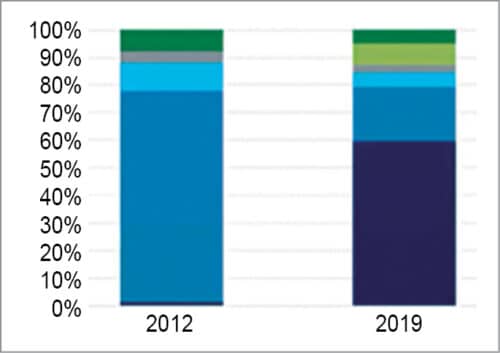5G is seemingly the next big thing of the current decade, so it is about time the world adapts to its offerings and moves ahead along with it. Let us try to understand how it will affect the ongoing industrial revolution or Industry 4.0.
Today, manufacturing is the first thought that comes to our minds when we look at an industrial setup that predominantly consists of mining and power grid. In order to digitise the industry entirely you need to ensure that all the Internet of Things (IoT) devices, robots, and drones across the entire country are connected. You need to run real-time applications to enable the strict need for industrial applications, hence, creating a need for reliable connectivity that supports high bandwidth and low latency at the same time.
Let us look at a few reasons for requiring these applications:
Enhanced mobile broadband:
- 20/10 Gbps DL/UL
- 4ms user plane latency
- Mobility up to 500km/hr
Ultra-reliable low latency communication:
- 1ms user plane latency
- Highly secure/resilient
- 0ms mobile interruption time/always available
Massive machine-type communication:
- 1 million devices per km square
- 10+ years battery life
- 20dB coverage enhancement
Private 5G and edge cloud may disrupt emerging technologies
A Wi-Fi network is most suitable for the indoors, but it is not scalable when you have to cover it on a 10 square kilometre area. To do that you will have to put a Wi-Fi modem at every 10 to 20 metres, which is impractical and costly at the same time. In this case, a cellular network is the most appropriate option.
We already have working 4G networks. These networks are predominantly public networks and not private networks with an enterprise. Similarly, cloud is also not physically present within an enterprise.
You cannot be certain of the data centre location. Even if you did know about its location, you will still not be able to know the amount of latency it will take, because it is going through the web network and not through the public network. This is why this latency needs to be changed.
With the introduction of 5G this can be dealt with easily. It allows you to create an alternative Wi-Fi network within the enterprises. It ensures low latency and high throughput as well as privacy.
Along with that, you also need to have a miniature version of the cloud, which we call the ‘H’ cloud. It is more reliable for things like augmented reality (AR) and virtual reality (VR), video analytics, robotic operations, and autonomous vehicles, as it guarantees low latency. It is also important to note that the cloud is essentially for bookkeeping and data management and not for any computation tasks.
Information technology (IT) applications such as Zoom, system applications and products (SAP) can be run properly on Wi-Fi but operational applications cannot. This is almost a 517 billion dollar market, which will be disrupted eventually.
Industry 4.0 use cases
Industry 4.0 has many use cases, some of which are mentioned below.
Logistics. Warehouses tend to be extremely huge, hence requiring the need for digitising them as real-time tracking of the devices across the warehouse is extremely important. Drones can be used for tracking purposes while robotic automations can assist with moving the goods from one place to another. AR/VR based applications can be used to assist the training of the employees in real time.
Mining in India is of two kinds. First one is called open-pit mining. This kind of mining does not require you to get into a tunnel. You essentially do the mining in the periphery and do the extraction.
The other kind of mining is called closed-pit mining. This method of mining requires you to go underground inside a tunnel. There can be around 10 to 22 tunnels as you go down, and each of them can be one to two kilometres long.
In places like Australia, a lot of automation has been done already. But in India things are still done manually. Miners enter closed pits and use a USB stick to take the data out from the sensors installed in that area. Only then can they connect it to their office systems and servers to use it.
This creates opportunities to digitise everything. By automating the unmanned vehicles this problem of data extraction can be solved so that no human has to enter these mines. This would significantly reduce the risk of any kind of disasters.
You cannot send people inside the mines for causing a blast for a specific purpose. In such cases you can send drones equipped with 4K cameras and take a survey of that area.
Oil and gas. Oil and gas exploration is divided into three predominant parts, namely, upstream – offshore, midstream – pipeline, and downstream – refinery. During upstream – offshore exploration you are basically looking for places where you can find extra oil. Similarly, there is onshore exploration where the exploration is done on land, unlike offshore.
Oil and gas exploration requires a lot of systematic data collection. Heavy analytics is required to find out the right places to conduct these explorations. Private 5G can play an important role to achieve the same. This makes a huge scope to increase productivity and save lives.
Manufacturing. There is a real use case at Fujitsu where they use private 5G network as well as edge computing for autonomous guided vehicles. They use 4K cameras to ensure that these vehicles are moving properly. They collect the data from these 4K cameras as well as sensors, which allows them to know about their real-time movement.
Similarly, in the manufacturing assembly lines they use cameras to ensure the work is being done the right way. They use artificial intelligence (AI) analytics tools to monitor everything. If they find that someone is not doing the work correctly, the AI gives a proper feedback about it. Training is also being done on the go with the help of AI in real time.
Transformation towards openness and disaggregation
Data centres of companies like Facebook and Google have moved to enable openness and disaggregation, especially in the networking space. Back in 2012, networking within most of the data centres that required switches, routers, and other network appliances were all properties, which means that they were owned by the original equipment manufacturers (OEMs). They wanted to run an operating system on multiple pieces of hardware, which was not possible at all.
Some of the hyperscalers like Facebook and Google found an opportunity and started using some of the white box hardware. White box hardware can be commercially used right off the shelf. These are servers which are based on open hardware designs that you can easily procure.
After you have taken the white box hardware you can then basically put any open software in there. Now, open software can be taken from various vendors and can still run on the white box made by any of the multiple companies. You can even change the software later, if you need to, and still be able to run it on the hardware. This is also called disaggregation.
The movement from proprietary solutions to open and disaggregated software and hardware in the data centres started in 2012 (see Fig. 1).

The white box use was very miniscule at about 2% in 2012. But by 2019 the white box use dominated the market and became around 59%. This was an eye opener for the telecom industry and a lot of enterprises too. Since then, disaggregation and openness has become an effective standard in the data centre market.
This was also the time when our company (Niral Networks) also started to envisage what it wanted to do. Interestingly, even big companies like Cisco are also moving towards disaggregation, because that is where the market is headed.
Transformation towards openness and disaggregation in 5G RAN and core
Initially the radio access network (RAN) was proprietary but with the introduction of open radio access network (O-RAN) it has been divided into three parts now. The first is the radio unit (RU) which acts like antennas. Then there is a distributed unit (DU) and a centralised unit (CU). Now, instead of making use of the hardware you can simply use the cloud to run DU and CU.
The important parts in the 5G are the radio network, as mentioned previously, and the transport network that sends the radio signals to the centralised core. There is a transport network between the 5G network and the centralised cloud using a router which is also getting disaggregated.
NiralOS network operating system
- Private 5G Core Cloud is a native private 5G core software for mobility, authentication, security, session, and policy management. It contains the 5G network functions like AMF, SMF, AUSF, DM, NRF, and UPF. Niral 5G core also has a compact user plane function (UPF) to provide local breakout within and enterprise when integrated with TSP’s centralised 5G core.
- Mobile Edge Cloud Kubernetes and virtualised edge cloud infrastructure creates a mobile edge cloud within an enterprise with open APIs to host third-party applications like AR/VR, robotics, drones, AI/ML, and video analytics for low latency and privacy.
- Centralised Controller provides centralised management, orchestration, zero touch provisioning, and monitoring of multiple private 5G networks and mobile edge cloud at various sites. The controller can be hosted in the public cloud to centrally manage and monitor multiple private 5G networks.
NiralOS specifications
- Release-16 compliant 5G core for private 5G deployment.
- 5G network functions like UPF, AMF. SMF, AUSF, UDM, and NRF
- Kubernetes based cloud-native network function
- DPDK+VPP based user plane (UPF) acceleration – linear scaling per CPU core
- UPF local breakout for easy integration to TSP’s centralised 5G core
- Support of N1, N2, N3, N4, and service based interfaces for 5G SBA
- 5G core deployed on COTS hardware of various form factors and integrated with 5G radio
- Kubernetes and virtualised cloud agnostic edge cloud to host third-party applications
- Open APIs for integration of third-party applications to Niral 5G core and edge platform
- Web based dashboard for subscriber provisioning configuration and management
We have done some indigenous end-to-end integration with a radio company in India, so we can provide an end-to-end 5G system. We have recently been awarded for innovation in 5G and look forward to achieving more such feats.
This article is based on a tech talk by Abhijit Chaudhary of Niral Networks at Open Source Conference 2022 that was organised by Samsung R&D Institute India, Bengaluru, and IEEE ComSoc Bengaluru Chapter. It was transcribed and curated by Laveesh Kocher, a tech enthusiast at EFY with a knack for open source exploration and research.
Abhijit Chaudhary is Founder and CEO of Niral Networks








